
The Top 10 Reasons to Outsource SEO in 2022
What Exactly Is SEO Outsourcing? Why Should You Consider It?
Most marketing teams have a lot to do and not enough time. This is especially true when it comes to search engine optimization (SEO). Some people interpret the term “outsourcing” to suggest that your in-house staff is never involved — this is never the case. Outsourcing SEO will save you time and money, but a disjointed SEO staff is a formula for catastrophe. Indeed, the greatest SEO “outsourcing” entails a close collaboration between your in-house team and an SEO agency, ensuring organisational goals and marketing team KPIs and campaigns are aligned with SEO efforts, and sourcing in-house industry expertise as necessary.
Because of shifting algorithms, severe rivalry, and a general lack of awareness of the industry, SEO may be exceptionally hard. It may also take some time to see the desired results. However, those outcomes can offer tremendous returns in the long run.
Juggling expectations regarding time, money, and human resources allocated to this service can be one of the most challenging difficulties for anyone wanting to win at SEO, which is why organisations frequently choose to hire outside help to get things done faster and at a lesser cost.
When it comes to outsourcing any component of a business, there is often some trepidation and concern. This is because you will have to put your trust in a third party. The anxiety is legitimate, but it just means that any organisation contemplating this step should only work with certified and proven vendors.
Outsourcing SEO’s Effects: Positive or Negative?
Outsourcing something as important as SEO can have a huge impact on your company and the efficiency of your in-house marketing staff. It might have either a devastating (bad) or a favourable impact. It’s hazardous, and there will be no quick wins – it’s a lengthy game – but it may be a rewarding game worth playing.
These are the top ten reasons why any firm serious about digital marketing should consider outsourcing or “nearsourcing” their SEO operations to a fractional marketing agency. With all of these benefits available when using an agency to provide SEO services, the pros greatly outweigh the cons. Let us spend some time delving into each of these.
Regain Valuable Time
This is the first and most fundamental advantage of outsourcing your SEO efforts. Optimizing your website’s pages and content to rank better on search engine result pages (SERPs) takes time, especially if the people in charge are inexperienced. Having experienced professionals handle this aspect of your SEO campaigns will save your firm a lot of time.
Cost-Effective
SEO is a challenging and intricate process. It is usually not worth the time and money to train an in-house full-time employee on SEO — they may not have the necessary skillsets to begin with, or the training may take months. Furthermore, even if they master SEO, they may not have enough time in their day to implement it. Marketing departments are already overburdened.
You’ll need someone with years of experience or a team of various pros who specialise in specific areas of SEO and digital marketing campaigns if you want it done right. Outsourcing SEO services will give your firm with a full team of professionals for a fraction of the cost of keeping them in-house.
An SEO company or agency can give a lot of value for a relatively low price. Keep in mind that SEO pays off over time. Doing SEO wrong from the start can be significantly more expensive than getting it properly.
Quicker Results
A digital agency or SEO service provider can take what you have and put a whole digital marketing strategy behind it, such as a keyword strategy, lead generation and content marketing strategy, and the like, so you can start seeing results quickly from the material and traffic you already have. Developing and implementing a proper SEO strategy on a site with otherwise good traffic and content can often result in reasonably quick results.
You may also expect work to begin immediately if you outsource SEO, as opposed to the customary delays that result from in-house pre-planning and preparation before implementation. After all, less experienced professionals will need time to learn and figure things out before they begin, whereas proven SEO specialists will encounter little to no learning curve.
Furthermore, your SEO efforts should be measured, tested, and refined over time — this is why it’s called Search Engine Optimization. Doing a little amount of SEO in-house and then reducing it over time is a proven way to see results fall.
There is no learning curve.
If your organisation is just getting started with SEO, chances are the personnel who take on the responsibility will spend a significant amount of time learning the ropes, detracting from content optimization and material development in general.
SEO specialists are, well, specialists. They are well-versed in SEO and its associated issues. This implies they won’t have to waste time learning anything new. They are prepared right away.
Improved Marketing Strategy
Many businesses use “SEO” by just generating content and hope for organic traffic and leads. While hope is wonderful, it has little to do with good SEO.
A good SEO company will assist you in developing a competitive strategy in the following areas:
- Strategy for keywords
- Content strategy for multiple platforms (blog, YouTube, social media, etc.) and content types (guides, tutorials, topic clusters, webinars, etc)
- Schedule for creating thematic content
- Marketing with content (getting leads and business from your content creation)
- Establishing links (getting backlinks from valuable domains)
A full-service digital marketing agency can take what you have and turn it into a digital marketing strategy, which means connecting your SEO efforts to your video creation efforts, social media efforts, email campaign efforts, and so on, while also ensuring that your SEO efforts aren’t negatively impacting your conversion optimization (CRO) efforts, the overall user journey, and user experience. Some SEO firms who specialise in SEO might actually have a negative impact on your total digital marketing since they don’t evaluate the impact of their efforts on areas such as user experience, conversions, and the like – SEO should not be done in isolation.
Maintain White Hat SEO Practices
A competent SEO business will use white hat SEO tactics, which are the “positive” types of activities that can boost your SEO rather than hurt it, as “black hat” SEO approaches can. Obtaining backlinks from bogus websites and directories, for example, is a black hat SEO strategy that will hurt your SEO and domain authority score.
Gain Access to Effective SEO Tools and Knowledge
SEO firms typically have access to cutting-edge SEO techniques, which can be costly or difficult for marketers to justify in their budgets. Furthermore, learning and harnessing the power of these tools, such as SEMRush, Moz, and Ahrefs, not to mention more enterprise SEO solutions like seoClarity and BrightEdge, can take years.
SEO is also one of the services provided by digital marketing organisations. You receive access to not only SEO skills but also competence in related areas. This implies that when you outsource SEO services to a digital firm, you gain access to a complete team of digital specialists, tools, and resources to assist you with your demands.
Improve Your In-House Team
Burnout is a genuine issue. Overworking people and subjecting them to menial duties on a regular basis may and will have an emotional and psychological impact on their mental health and productivity.
SEO job can grow monotonous after a while. Long hours are spent sifting through pieces of information about the same issue and running through vast lists of terms, examining their search traffic and performance. Time and time again.
When you have a whole staff handling the work, you solve the problem by rotating them on a regular basis. But what happens when the team is small or consists of only one person?
Outsourcing SEO solutions will relieve your in-house marketing team of this type of labour, allowing you to assign them to other projects. There are various more aspects of digital marketing that require the attention of your team. By relieving them of the time-consuming demands of SEO, they are free to focus on those other things, further optimising the use of your in-house resources.
Maintain Knowledge of Trends and Tools
Proper SEO necessitates the use of numerous tools as well as a grasp of changing trends. Google, for example, updates its search algorithm approximately 500 times every year. Most of the time, the adjustments are subtle yet significant.
SEO agencies are constantly on the lookout for market developments and new tools. They have no choice. This is their main source of income. Your organisation gains access to a constantly updated supply of information by outsourcing.
Obtain an Objective Point of View
It is easy for people wearing a company shirt to become enamoured with the brand. This is not necessarily a bad thing, but it might cause issues when objectively judging work. Recognizing fractures and defects gets more difficult when you are too close to something.
One of the most underestimated advantages of outsourcing your SEO services to an agency is that you will have employees that are dedicated to honesty. Someone on your in-house team may choose to or be consciously unable to detect errors in his work because his career is at stake; but agencies must be objective and deliver outcomes because their reputation is at danger.
This means you’ll be able to acquire objective third-party assessments of what’s going on that are extensive, efficient, and detailed.
Outsourcing / nearsourcing SEO services does not have to be a high-risk venture. It has the potential to be a good turning point for any firm that takes the time to study and evaluate prospective sources.
Weigh all of your options, make an informed decision, and watch your costs fall as your results skyrocket!
Are you concerned about outsourcing SEO or another form of digital marketing? I get it. Please contact me if you have any queries or issues. I’m here to help!
The How and Why of Content Pruning for SEO

A widespread misconception in the SEO industry is that you must post ‘x’ amount of content on your website on a regular basis in order to rank well over time. True, supplying your target audience with valuable, relevant, and optimised material that answers queries and gives insight will boost your visibility. The reverse impact can occur if the content being produced is inaccurate, badly designed, or lacks purpose.
It’s critical to check and assess the material on your website on a regular basis to ensure it’s functioning well and not becoming stale. There are likely to be pieces that no longer align with your brand, are no longer true in terms of their information, or content that isn’t helping your brand reach any specific goals, especially on major sites that have been producing new content for years.
This is known as content pruning, and this article will help you understand what it comprises, as well as why and when it is vital to prioritise pruning over developing content.
What exactly is content pruning?
The removal, consolidation, or re-optimisation of underperforming material across your website that provides no relevancy, value, or insight for your target audience is referred to as content pruning. It entails examining information for a variety of characteristics such as visibility, goals, accuracy, accessibility, and others. Content pruning should not be confused with culling, because it is not as simple as deleting large amounts of content and being brutal; this can cause far more harm than good.
Let’s look at the broad definition of ‘pruning’:
“trim (a tree, shrub, or bush) by removing dead or excessive branches or stems, particularly to promote development.”
The same is true for content pruning for SEO: it is about identifying content that is no longer serving a function and eliminating, re-optimizing, or consolidating it to ensure higher quality content across your site, and hence a long-term increase in visibility.
What is the significance of content trimming in SEO?
Keep up with Google algorithm adjustments.
Google’s algorithm improvements are always emphasising information’s quality, accuracy, and authority. In addition, their ranking algorithms are getting significantly more perceptive about what constitutes quality material. The days of exploiting scraped, keyword-heavy content to rank for specific keywords are long gone.
Material pruning enables you to find any older pieces of content that do not align with or violate Google’s quality rules, allowing you to adjust or eliminate this content to improve the overall quality and authority of your website’s content. Poor, scraped material or blackhat practises that you may have employed in the past may have gone unnoticed by you, but they will not be ignored by Google and may impact your site’s visibility.
Achieve certain targets more effectively
Content published on your website should be consistent with your brand’s long-term objectives. Articles and landing pages can be used to build backlinks, convert visitors, solicit inquiries, or increase traffic and brand awareness. With sites that contain a large amount of content, there is a good probability that not all pages will be fit for purpose over time, or that not all of your pages will have any purpose at all.
The purpose of content pruning is to find old or even recent information that does not correspond with your business goals and then alter, remove, noindex, or redirect it to more relevant, better-optimized content. It is the process of determining the objective of each page on your site, whether the page is optimised to achieve that aim, and the page’s performance thus far.
For example, if the goal of a page was to produce backlinks but your digital PR effort failed, consider why and whether the page can be revised, further optimised, and outreached again. Another example might be a page with insufficient material. With a page on a related topic, the current material can be reinforced or consolidated. You can reap tremendous benefits by tailoring your content to its intended purpose.
Look for old content
Content decay occurs when older pieces of content lose their relevance or become erroneous over time. Content pruning entails reviewing potentially stale content like this on a regular basis to ensure your website is providing up-to-date, factually accurate advice, whether you decide to update the page, redirect it to a more relevant page on your site, noindex it to keep crawlers away, or delete it entirely and display a 404.
Determine competing content
Internal competition is common, especially if your brand or the website you’re working on is vast, such as those with large content libraries. This is known as content cannibalization, and it occurs when numerous pages on a website compete for the same keyword or keywords. Most of the time, it is inadvertent and goes unnoticed, but it has the potential to drastically reduce the visibility and success of all competing pages. Content pruning allows you to identify instances of cannibalisation and devise a plan of action to address them. For example, you may decide to combine two pages on one URL with improved exposure in the goal of generating a larger, more effective, and more valuable page.
So What do you do?
Now that we’ve established what content pruning is and why it can be extremely useful and effective for SEO, let’s get into the specifics of how to implement it.
Design your dashboard
To begin, you’ll need to collect a wealth of relevant data in a spreadsheet to give yourself the best chance of evaluating your content and providing effective recommendations. The simplest way to achieve this is to crawl your site with a tool like Screaming Frog to collect all of the essential data. You can also export a list of all indexed URLs from Google Search Console.
I recommend importing a full year’s worth of data into your dashboard to get a comprehensive picture of how your pages are performing.
Creating a dashboard with all of the metrics you intend to analyse might be tedious and time-consuming.
Here’s a list of the data we recommend entering into a spreadsheet, as well as the tools you can use to do so:
Screaming Frog
If your site has fewer than 500 URLs, you can crawl it completely utilising Screaming Frog’s free SEO spider tool. You can obtain the following information from this point:
URL index
Metadata (alternatively, use an IMPORT XML formula to pull meta titles and descriptions into a Google Sheet, such as =IMPORTXML(“URL”,”/title”))
Heading structures and H1s
the number of words
Instances of duplicate content
Analytics by Google
The greatest places to find your data are within Google’s own tools. You can export the following data from Analytics along with your URLs:
Organic traffic, which includes Organic Users and Sessions
Engagement Time vs. Bounce Rate (GA3) (GA4). Using this data, you may discover pages where users leave almost instantly or pages where they stay a long period. However, don’t rely solely on these indicators; someone may leave a page if they rapidly found what they were seeking for.
Organic Conversions, Revenue (if relevant), and/or Objectives To prune your content, you must collect data that is relevant to your business strategy and overall goals. E-commerce companies, for example, may wish to track how many visitors purchase after viewing a given page of content, whilst other sites may be interested in how many people submit an enquiry or perform another specific action on the site.
Google Search Console
The Search Console is handy for checking which pages are indexable and exporting a list of all internal and external links on the site.
Rank tracking software
Before recommending a course of action for SEO, it’s also necessary to obtain a broader understanding of how your pages rank. I propose using Ahrefs, SEMRush, or another similar tool that allows you to export a list of URLs and their top-ranking keywords for this purpose.
These tools are also valuable for determining whether pages have backlinks leading to them and the authority of these links, as well as determining search intent and the various search engine results page (SERP) elements available for specific keywords. For example, you can quickly determine whether a SERP has the potential for a Featured Snippet, which your page could benefit from better optimising.
Establish your priorities
After that, you can begin pruning. If your site is quite extensive, for example, with thousands of posts published throughout time, you will need to determine your priorities. You might wish to focus on pages that were published before a specific year, have few to no backlinks, or earn less than a certain quantity of organic traffic or conversions each month. Again, this is depending on your business and the long-term goals of your site, whether that is better visibility in a specific sector or increased conversions.
Create a plan of action.
While reading your blogs, articles, news releases, or other forms of material on your website, you should keep a list of potential actions in mind.
This stage of the process allows you to vet your older content and create a list of planned actions, such as reoptimizing a page for different or additional keywords, consolidating an underperforming page with a stronger page on the same topic, leaving pages alone that are performing well or aren’t designed for SEO purposes, or simply scrapping pages that aren’t ranking or generating any traffic.
Among the possible actions are:
Consolidation (For example, if you identify that multiple pages on your site are competing to rank for the same keywords or find a page that is thin on content, you may want to consolidate these onto a stronger page.)
Update (For instance, if you discover that information, statistics, or facts used throughout your material are no longer relevant or correct and must be updated.)
Re-optimise (For example, if your page isn’t ranking for its target keywords, it could be because it doesn’t fit the proper search intent and should be optimised for an alternative set of keywords.)
Repurpose (For example, if you identify pages whose purpose does not fit the search intent. This might happen when a page has too little information or when readers are looking for a page with a lot of media, such as images or an infographic alongside copy.)
Remove (For example, if you discover a page with relatively little material or that is completely irrelevant and has no room for growth.) Always be cautious about eliminating potentially valuable content and make every effort to reroute people to related pages or show a bespoke and useful 404 page.)
Monitor (For example, if a page was recently released but isn’t currently ranking for your target keywords, create a note to monitor it in the future months and tweak as needed.)
There is no action. (The chances are that if you routinely publish high-quality, well-researched, and optimised content, a lot of it will be doing well as is and can be left alone to age and gain in visibility over time.)
Evaluate the results
Measuring the effects is arguably the most critical aspect of the content trimming process. If you evaluate and update a lot of your material but don’t prioritise assessing the effects of your efforts, you’ve completely defeated the point.
As you move through your material, ensure that everyone involved is aware of the state of specific pages and when new and enhanced information has been uploaded so that you can track the effects of these changes in the months to come. This allows you to readily determine your ROI for your time spent, whether it’s more organic traffic, conversions, or backlinks. Of course, keep in mind that your results may not be immediate; it may take time for Google to recrawl and rank your material correctly.
To sum up
Material pruning can be equally as beneficial as, if not more so than, developing fresh content for SEO. In addition to preventing your website from becoming overburdened with low-quality or repeated information, pruning allows you to be aware of the value each page provides and measure results accordingly.
Google is emphasising content quality and authority, so reviewing what you already have and making sure it is unique, valuable, helpful, and reliable will only benefit you.
A checklist of questions to ask yourself when reducing your content.
Use the checklist below to ensure you’re properly evaluating a variety of essential variables while pruning your material;
Intent to search for keywords Is your content still in line with the search intent of visitors if you have targeted keywords through it? Has the search intent for those terms shifted slightly over time, and if so, how can you adjust your content to better reflect this?
Page function. What does a piece of content serve? Is it intended to inform, educate, convert, or entertain?
Page objectives How will you assess the success of a piece of content? For example, if the goal is to convert or produce leads, you must ensure that conversion tracking is properly configured. If the goal is to entertain or attract attention, you may wish to track the number of backlinks obtained.
Internal rivalry. Are there several pages on your site that compete for the same set of keywords? If so, is it advisable to aggregate these or reoptimize certain pages?
The average amount of time spent on a page. Are users visiting your blog pages and then leaving without engaging? If this is the case, what might your page be lacking that your users were looking for when they searched for your target keywords?
Accessibility. Are your sites readable in terms of text size, font type, and colour contrasts? Does your written and non-written material consider website accessibility features like alt tags and clear heading structures?
Stale or out-of-date content Is your content showing symptoms of deterioration? Is information presented, for example, that is no longer accurate or relevant to your business offering or goals?
Content that is too thin or of poor quality. Is there ever a time when there is little to no material on a page for Google to crawl? If so, is this consistent with competitors, or do these pages need to be improved or removed? Are there any situations when your brand’s present rules or standards need to be improved?
Content duplication Is there content on the site that has too many similarities in terms of goal, keyword targeting, or wording?
Content that is underperforming. Is there any material on your site that has been present for a long time but isn’t producing organic traffic or ranking for keywords? If so, does the page provide additional value, or should it be improved or removed?
For more help or advice on how to best prune your existing content – drop me a line.

How to Get Your Company Listed on Google Maps
Do you want to know how to get your company listed on Google? Adding your business to Google Maps is one of the simplest methods to accomplish this.
The procedure is free and straightforward. You may get your business on Google Maps by going directly to Google Maps or by using Google My Business. In any event, Google will want you to authenticate that you are the business’s owner.
Is it worthwhile to use Google Maps for business? Absolutely. Within 24 hours, 76 percent of people who conduct a local search visit a physical business or shop. 28 percent of them make a purchase in the end.
Another way to look at it is that adding your business on Google Maps could enhance your discoverability by 76%. It can also increase your sales by up to 28%.
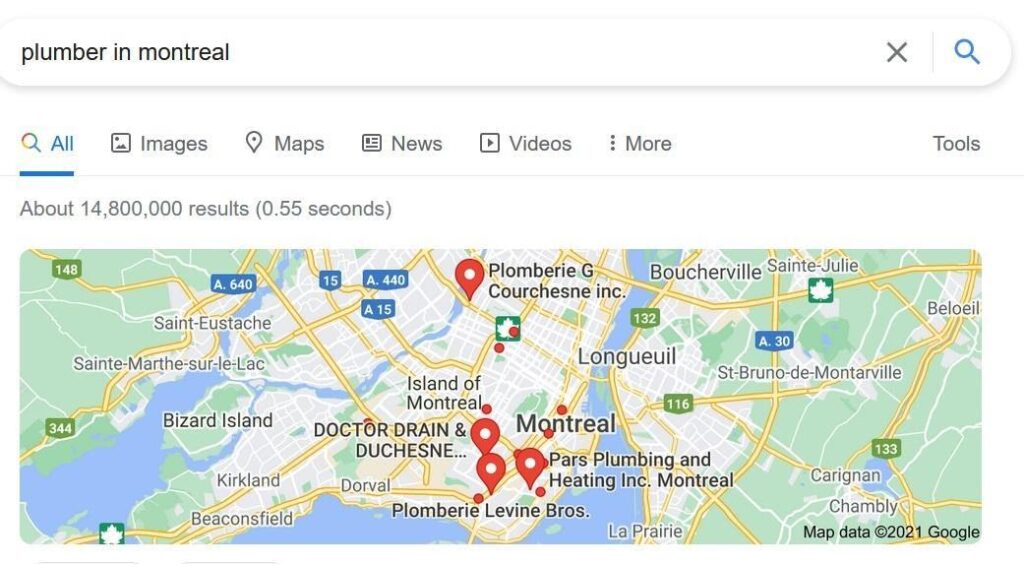
What Is Google Maps and How Do I Use It?
In a commercial environment, Google Maps makes it possible for consumers and clients to find your company using a Google search. When activated, your company will appear on Google when customers search for local businesses that provide specific services.
For example, if you are a plumber in Montreal, your company will appear when someone searches for “plumber in Montreal.” Here’s an actual Google Maps example, replete with actual plumbing firms.
How awesome would it be if your company also appeared in local searches? In fact, with a little more SEO, Google will feature your business in the Local Pack, making it even easier to find.
The Local Pack on Google is a “top three” list of the finest local businesses for various queries. Your website, directions to your location, ratings, opening hours, and any other information that may entice potential customers are all included in the listing. However, unless you list your business on Google Maps, it will not appear in the Local Pack results.
Google Maps may be the most significant component of any local SEO campaign because it makes your business easily discoverable in local searches.
How Much Does It Cost to Get Your Company Listed on Google Maps?
Adding your company to Google Maps is entirely free. You only need to create a free Google business profile. You can then add your business to Google Maps to reach more clients.
How to Get Your Company Listed on Google Maps
You can add your business to Google Maps in two ways. The first is to use Google Maps directly, and the second is to use Google My Business.
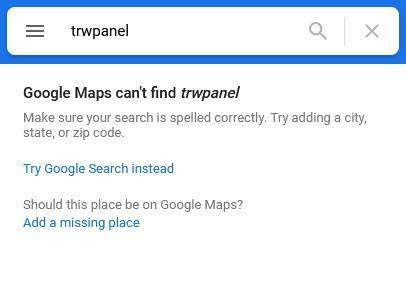
Step 1: Go to Google Maps and search for your company.
Go to google.com/maps/ and type in the name of your company in the search field. If your company appears, it is already listed. Because anybody may add a business to Google Maps, yours may already be listed.
If your business does not appear in Google Maps results, you will be given the option to “Add a missing place.”
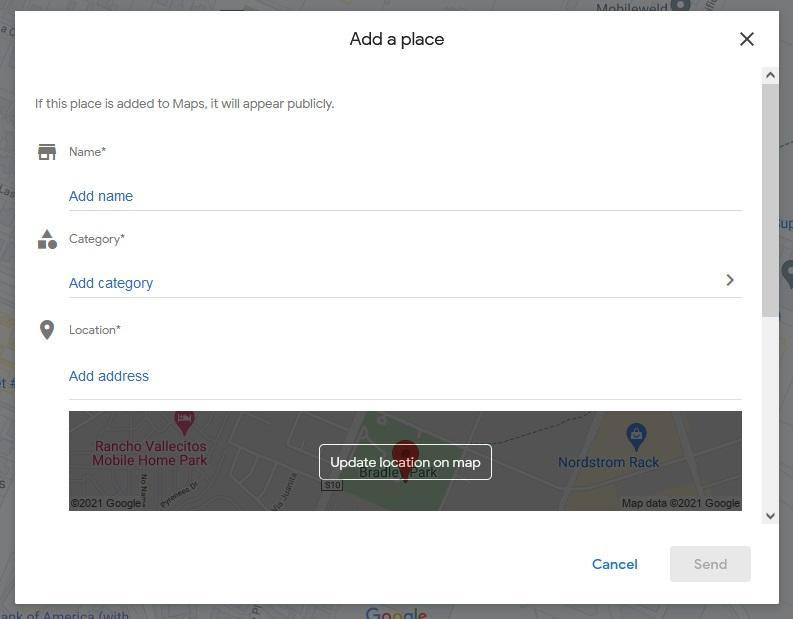
Step 2: Fill in the blanks.
Select “Add a missing spot.” The following window will allow you to submit information about your company. This comprises the name of your company, its category, and its location.
Your company will already be listed on Google Maps at this time. However, until you claim the listing, it will not appear on Google Maps or in the Local Pack.
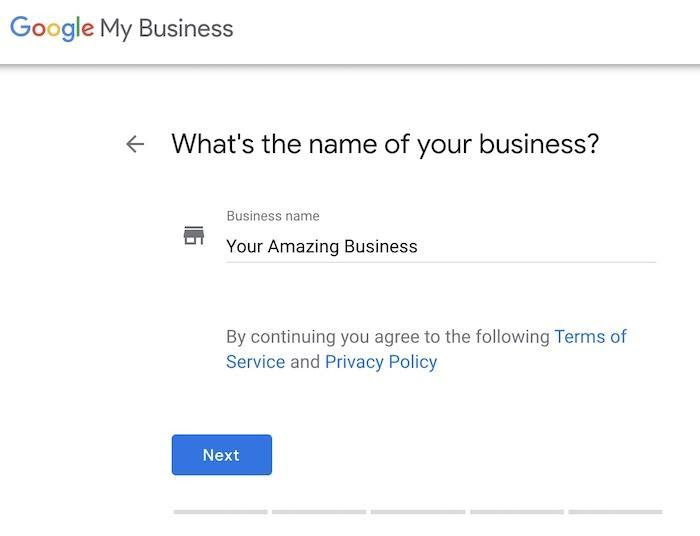
Step 3: Register your company.
You’ll see a link to “Claim this business” in the following window. This informs Google Maps that you are the business’s owner. As a result, Google will allow you to change any information as needed in the future. You can, for example, include your website, contact information, operation hours, and so on.

Step 4: Confirm the company’s legitimacy.
Google will need to authenticate that you are truly the proprietor of the business as you state in this final stage. Often, they’ll do this through an email-based postcard.
It should arrive within two weeks. Changes to any of the details will result in a new code from Google, which will necessitate a new postcard.
The postcard has a one-of-a-kind PIN that you enter online to verify your business. You must do this within 30 days after requesting the code in order for it not to expire. After verification, it usually takes a few weeks for your business to appear on Google Maps and other Google platforms.
How to Use Google My Business to Get Your Business Listed on Google Maps
Google My Business (GMB), now known as Google Business, is a free service for managing how your business appears on Google platforms such as Google Maps. You don’t need a website to use GMB, although having one helps a lot when it comes to ranking on Google’s search platforms.
Here’s a step-by-step tutorial to getting your business on Google Maps with Google My Business.
Log in to your business account on the Google My Business website. If you don’t already have an account, you can create one here.

Step 2: Look for your company.
Once you’ve logged in to Google My Business, search for your company precisely how you want it to appear in Google. If your company’s name displays with its address, that signifies it’s already on Google My Business. In that situation, you’ll need to claim it and prove that you’re the rightful owner.
If your company does not display in search, select “Create a business with this name.” Now, type out your company’s name precisely as you want it to appear on Google.
GMB setup – enter the name of your company that you wish to appear on Google.
Suffixes such as LLC and Inc. are permitted, but are not required.

Step 3: Select a business category.
On the next page, from a drop-down menu, choose the category that best fits your company. You can also type it in and Google will propose alternatives.
This is critical since it tells Google which local searches should display your business.

Step 4: Determine if Google Maps should display your company’s location.
If your company has a storefront or a brick and mortar site, you’ll probably want Google Maps to route clients and potential consumers to the exact location of your store or shop. In such scenario, when prompted if you wish to add a place, select “Yes.”
Do you have a physical location for your GMB setup?
If, on the other hand, you run your business from home, you’ll undoubtedly want to keep your location confidential. In that instance, selecting “No” makes more sense.
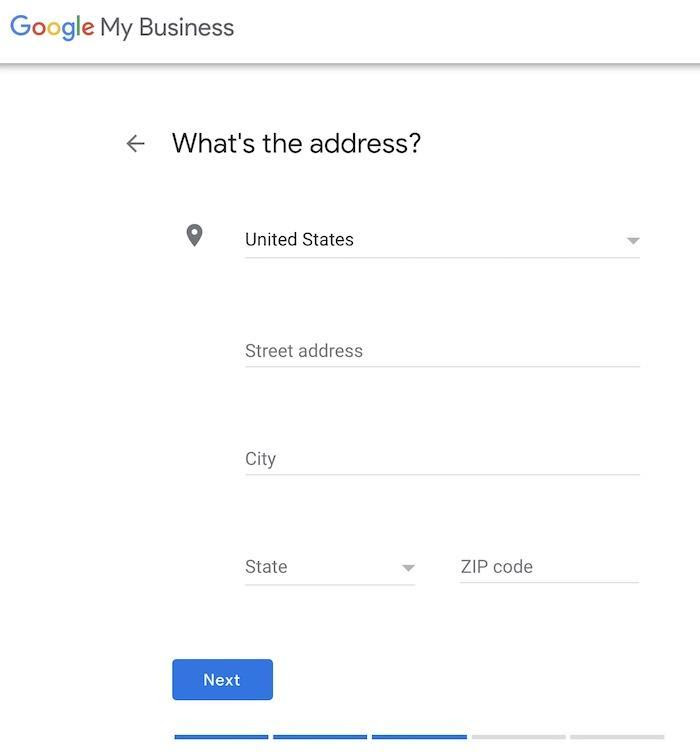
Step 5: Enter your company’s address.
If you want to display your company’s location, enter its address now. If you already selected not to display location, you can skip this step.

Step 6: Look for possible matches.
As previously stated, your company may already be featured on Google Maps and Google My Business. If Google finds any listings that match your address, it will display them.
If the discovered listing belongs to your company, you must claim and validate it. If not, proceed to pick “This doesn’t match.”
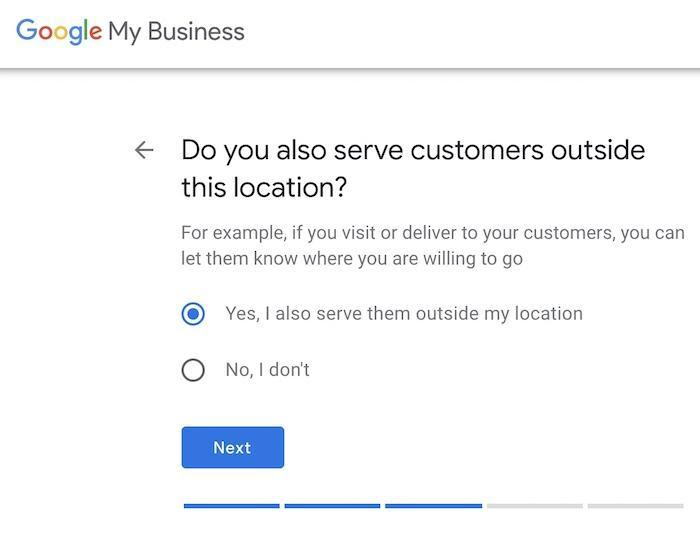
Step 7: Determine your service areas.
Does your company serve consumers who live outside of your immediate vicinity? If so, notify Google and proceed.
You’ll be asked to specify the locations you service.
Instead of individual towns and cities, you might choose to enter county names.
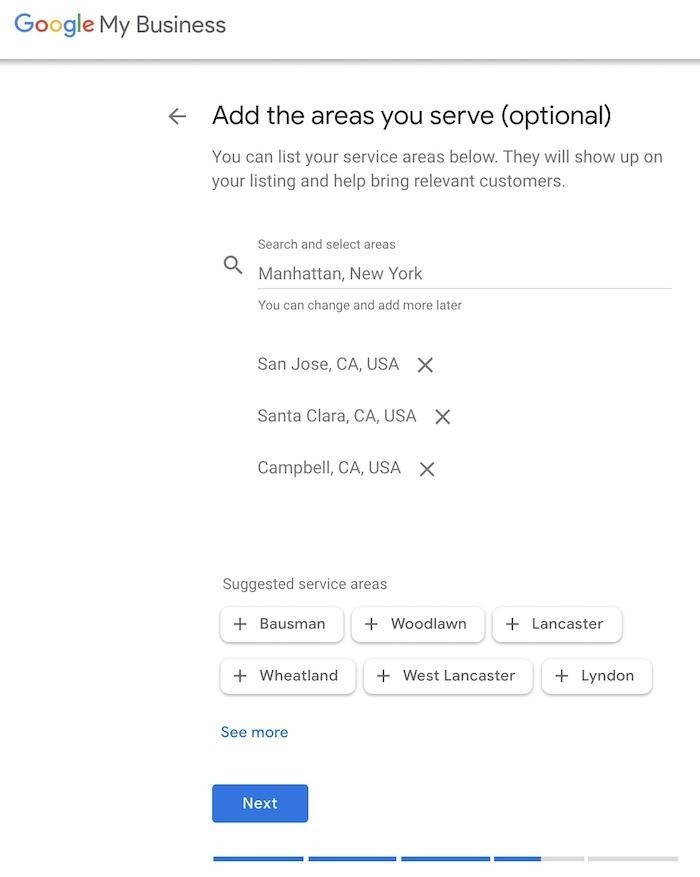
Lorem ipsum dolor sit amet, consectetur adipiscing elit. Ut elit tellus, luctus nec ullamcorper mattis, pulvinar dapibus leo.
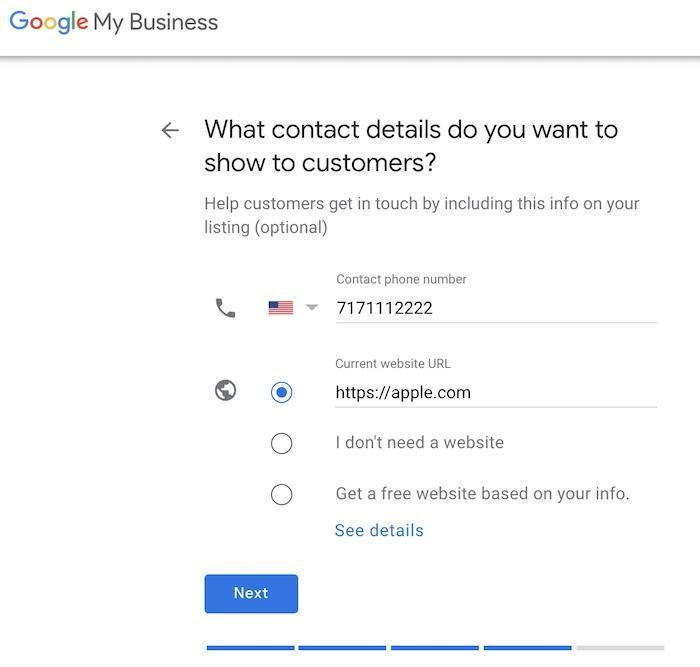
Step 8: Include your contact information.
Enter your company’s phone number and website address. Keep in mind that this is the phone number that will be displayed publicly by Google. As a result, it’s advisable to use your business phone number rather than your personal phone number.
If you don’t already have a website, Google can design a simple one for you. Simply choose “Get a free website based on your information.”
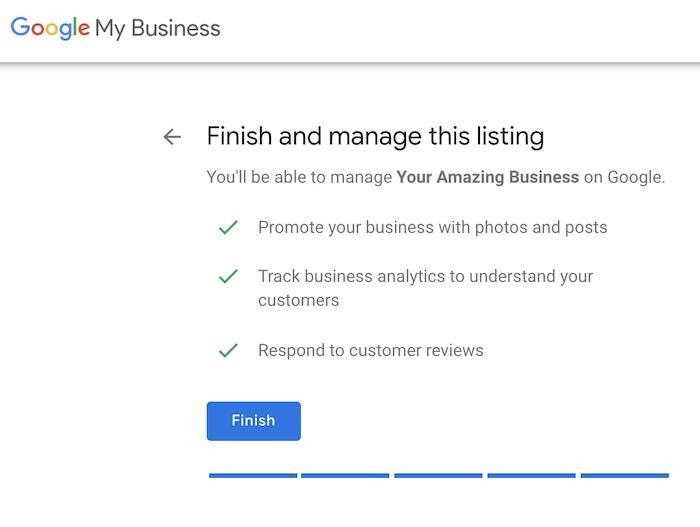
Step 9: Complete and validate your business on Google Maps.
To finish the process, click “Finish.”
You must still prove that you are the owner of the firm as claimed. Google will present you with five verification alternatives. The five are as follows:
- Google will send you an actual postcard.
- Email – An email with a verification code will be sent to you.
- Phone – You will receive a call from Google with a verification code.
- If you already have a Google Search Console account and a validated website, this option is available.
- Bulk — Select this option if your company has more than ten locations.
Step 10: Fill in the blanks with your company’s information.
Finally, GMB will let you personalise your business page. This includes entering your business hours, writing a description for your company, enabling messaging, submitting images, and so on.
This is followed by another page where you may add extra information, such as co-managers and a business logo.
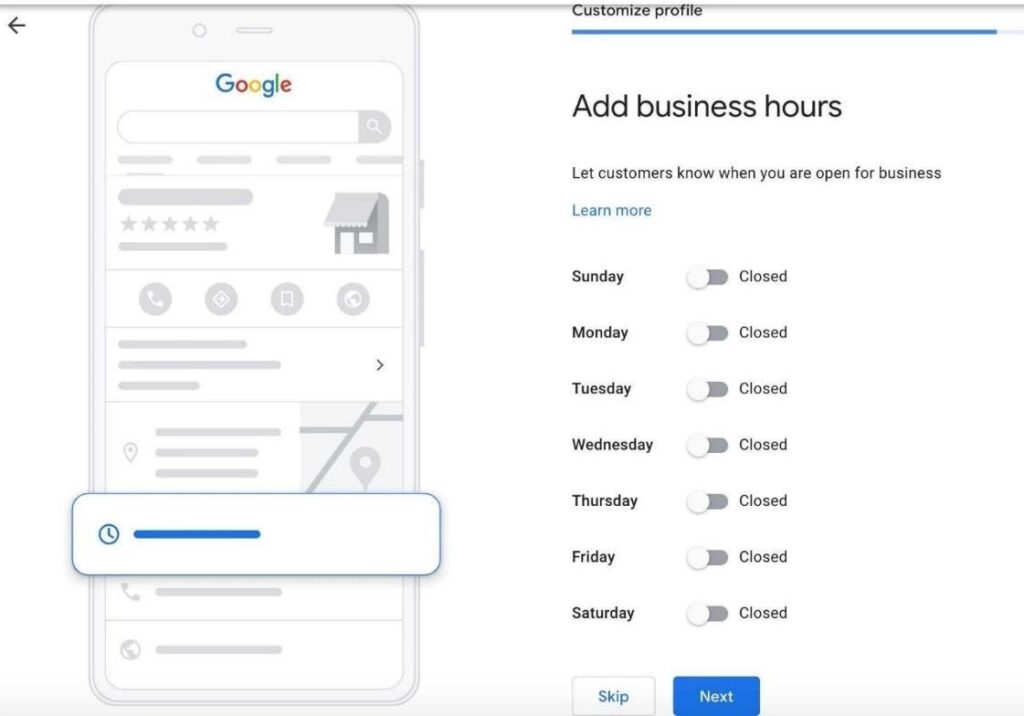
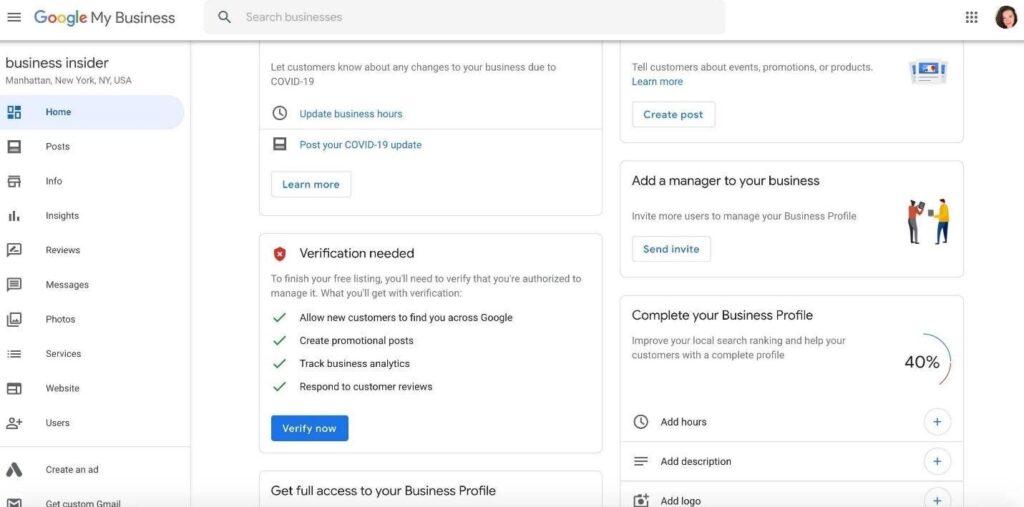
Is It Worth It to Advertise on Google for My Business?
Google My Business is well worth the investment. For starters, it adds your company to Google Maps, which improves both physical and online visibility. Second, GMB allows you to present as much information about your company to your customers as possible. Google My Business also allows you to browse and reply to consumer reviews and feedback. At the end of the day, GMB not only increases your customer base, but also your interactions.
Why isn’t my business listed on Google Maps?
If your company listing does not have a location authority, it will frequently not appear on Google Maps. For the business to appear on Maps, you must enable location.
Otherwise, it will only appear on Google Maps if a searcher is standing directly in front of your business when searching for it on Google Maps.
Make Better Use of Google Maps
Google Maps is only the first step in launching a great search engine optimization strategy. It must be combined with a decent website that can be found on Google Search, as well as conscious optimization work, in order to maximise your clickthrough rate and sales.
